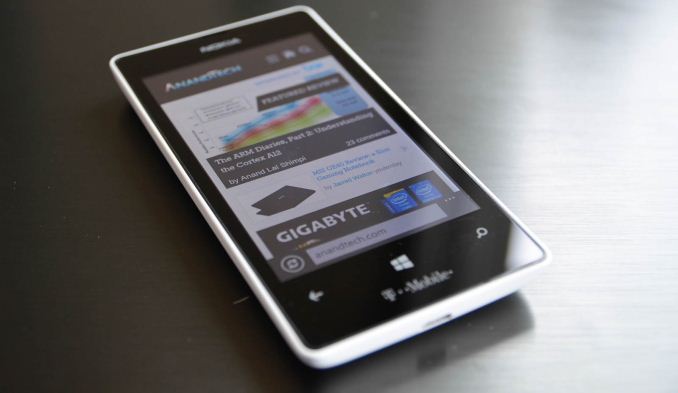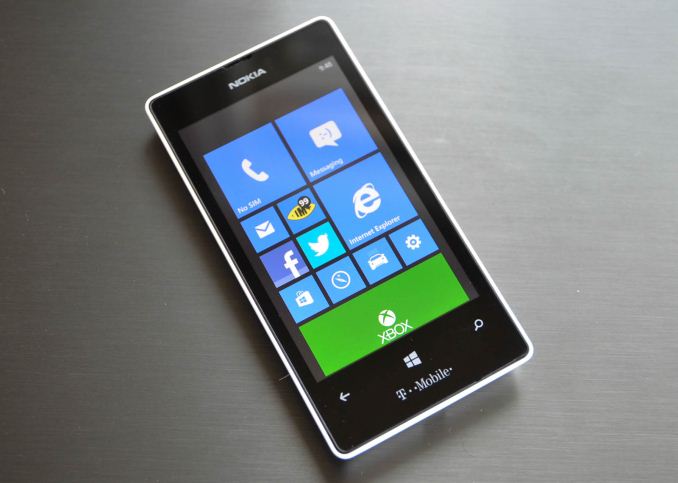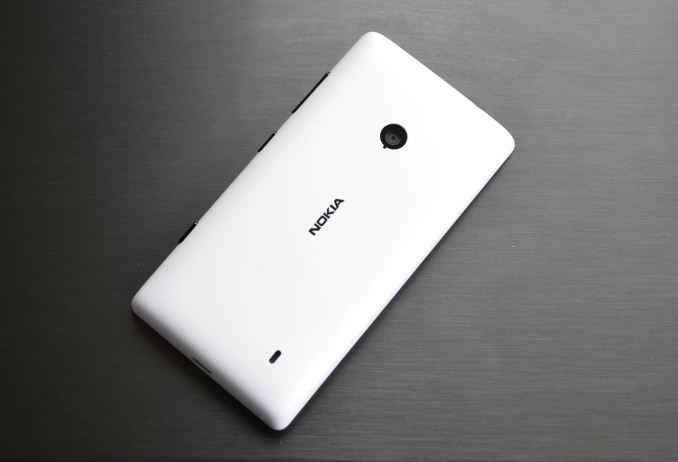Nokia Lumia 521: Quality Smartphone on an Extreme Budget
by Vivek Gowri on August 8, 2013 1:08 AM EST- Posted in
- Smartphones
- Nokia
- Mobile
- windows phone 8
- Lumia 520
- Lumia 521
While I enjoy the visual style, I’ve long been critical of Windows Phone as a platform, particularly when it comes to high-end devices. I really, truly believed in it when it launched in 2010, and actually spent a fair amount of time on a few different Windows Phones in the year following that. It had a lot of potential—and still does—but a few years later there are still some pretty glaring flaws, and that’s not a particularly encouraging sign.
As much as the Windows Phone interface has been lauded, I don’t think that’s necessarily accurate. It’s beautiful, yes—the Metro design language looks fantastic on the mobile form factor, and the animations have always been sleek and smooth, even on the slowest hardware. Everything visual about this interface has been finely crafted, and we’re left with an elegant, minimalist platform with bold shapes and vibrant colors. It’s a thoroughly modern visual style, and we’ve seen both Google and now Apple embrace the flat UI concept since Microsoft rebooted their mobile platform in 2010.
But from an interactions standpoint, I’m less sure about how Windows Phone goes about its business. Microsoft still hasn’t gotten the balance between visual sparseness and presenting information effectively. Far too often, you see important functions and options pushed into random corners of the interface, buried deep in some menu. Sometimes, they just don’t exist because a design decision was made in order to eliminate visual clutter. I can understand the complaints that Android has a cluttered or even convoluted interface, but Microsoft definitely seems to have gone too far in the other direction.
This is even more true with third party applications that try to adhere to the Metro UI design guidelines. Open the WP8 Facebook application and compare it to the Android and iOS versions to see what I mean. When the focus on visual minimalism impacts the usefulness and usability of the interface, there’s something wrong. We see this with Windows 8 applications as well, but there it’s less of an issue because there’s more screen real estate—and because you can just go back to the good old Windows desktop if all else fails. I don’t think anyone has managed to approach Apple’s balance of UI elegance and functionality, especially now with the interface improvements found in iOS 7.
I’m also tired of being told to wait for the next version of Windows Phone—first it was wait for copy/paste (NoDo), then wait for multitasking (Mango), then wait for WP8 to bring the NT kernel and fix everything, now wait for 8.1/Blue to bring it closer to feature parity. Microsoft cannot expect to gain back market share after this many years unless they’re willing to aggressively ramp their development cycle the way Google did with Android a few years ago—something they have thus far shown no indications of doing. They just haven’t iterated quickly enough, and I can’t think of a single time when I picked up a Windows Phone and thought it was feature competitive with Android and iOS. It’s not even because I use Google services; there are just a number of things that are legitimately missing from the platform.
At the flagship level, this becomes a problem—how do you sell a phone that’s theoretically competitive with the iPhone 5, Galaxy S4, and HTC One even though it doesn’t have real multitasking, a notifications center, a competitive browser, or much in the way of instant messaging support? Other than imaging, where Nokia is obviously a market leader, it’s hard to think of any compelling reasons to pick a high-end Lumia over one of the previously mentioned handsets. But at this price point and on a handset like the Lumia 521, a lot of those issues become forgivable.
$130 is on the border between high-end featurephones and the lowest of the low-end smartphones. We’re talking two year old devices—stuff like the Samsung Galaxy Exhibit II 4G (MSM8255 and Android 2.3) and the Sony Xperia tipo (tiny 3.2” display and MSM7225A with dual-core Cortex A5, but it does have Android 4.0). These are handsets that are either outdated, clearly flawed, or both. In comparison to those, the Lumia 521 comes out looking pretty good.

The best alternative in the Android world I’ve come up with is to spend a bit more to grab the prepaid LG Optimus L9 on T-Mobile for $179. That’s not an insignificant increase, but the L9 was a pretty great entry-level smartphone last year with specs that are still mostly respectable—a 4.7” qHD IPS display, OMAP 4430, a 5MP camera, and Jelly Bean 4.1.2—so the price delta is justifiable...ish. Of course, if you’re willing to go used, $150 can buy you basically any two year old flagship you want. I’ve seen the LG G2x and HTC Sensation regularly go for less than that on Amazon and Craigslist, though the Galaxy S2 has retained a bit more value and runs a bit more than that. The mid-to-late 2011 flagships remain pretty competitive with the budget handsets of today, but typically have better designs and end up being more complete all-around handsets because they weren’t subject to aggressive penny pinching.
It’s interesting to compare the 521 to the last Windows Phone I had for testing, the Lumia 810. That was the first Nokia WP8 device to hit T-Mobile, essentially just an operator customised variant of the Lumia 820. That was a good phone, if a bit dull design-wise and overshadowed in basically every way by the headlining 920. What strikes me as interesting is that the 521 is nearly as good as the 810 despite existing at a price point that’s less than half of what the 810 was. I’m definitely not the only one that feels this way, as the 810 was EOLed by T-Mobile earlier in the spring and replaced with the 521 (the high-end crowd will be served by the 925).
Beyond the display, which was one of the better parts of the 810, the day to day experience is rather similar, making it a bit hard to justify spending so much more for higher end hardware if you aren’t particularly concerned with the imaging side of things. This consistency across hardware platforms regardless of price point is really one of the strongest points of the Windows Phone platform with one caveat. This really benefits the lower-end devices, and the 520 and 521 are a really clear example of this, but at the same time, it’s a bit hard to explain paying four times more for a 920 or 925. Yes, the camera and display are better, and yes it’s a bit more powerful, but is it really worth paying that much more for something with many of the same software limitations? I’m not as sure. You can make a far better case for the 1020 (hereby dubbed the smartphone to end all connected cameras), but that’s a different article entirely.
Nokia tried their hand with budget Windows Phones last year with the 510 and 610, but the 520 seems to be a better thought out product and has so far been a hit in countries like India, where Nokia seems to be advertising quite a bit (based on the Indian television I’ve watched recently—this is what happens when I spend too much time around my parents). Samsung has used a similar formula in the past to great success with the Galaxy Ace, a phone that did have a major foothold in the Indian market despite running an ARM11-based SoC (which was laughable for a handset released in 2011). So it’s hard to complain too much about the 521 not having the greatest display or the longest list of features.
This is about providing a credible modern smartphone experience at the lowest of budgets, and in that sense, the Lumia 521 more than delivers, with a modern microarchitecture, generally decent specs, and a very solid no-frills design. Nokia is one of the world’s most respected handset manufacturers, a truly elite hardware design center. The Lumia 521 is one of their most compelling handsets in recent memory, and it’s difficult to give it more praise than that.












116 Comments
View All Comments
Crono - Thursday, August 8, 2013 - link
I love my Lumia 521. It's not my main phone - I have an HTC One for that - but it's amazing what $80 (got it from the HSN sale) gets you with Windows Phone. I had a HTC Trophy, Dell Venue Pro, Lumia 710, and a Lumia 920 (for a short while) before that, so I'm not new to Windows Phone, but this is the best budget phone of the lot. A similarly priced Android phone would either be hopelessly old and/or laggy with not enough RAM.Nokia can definitely beat Android at the low end since it runs so consistently even on older or lower specification hardware. The only problem is the profit margin is so low at that those points, but at least they are moving in the right direction with overall marketshare. And it's hard to argue what they are doing with their camera hardware and software, though one could argue that's a niche (but rather large niche) market.
IntoxicatedPuma - Thursday, August 8, 2013 - link
I've had mine for about 2 months now but use it as my main phone (had a Nexus 7 that I used for browsing/movies etc but gave that to my dad) and other than the battery life I've been really pleased with it. I'd really like to upgrade to a premium Windows Phone, and while the Lumia 1020 is really enticing I'd like for something more like a Galaxy Note.Wolfpup - Thursday, August 15, 2013 - link
I've had a 521 a few months too, and am really impressed. It doesn't come across as "good for the price" but more just "good". The article kind of overemphasizes the speed I think...it runs well, faster than higher end Android devices I have.Samus - Friday, August 9, 2013 - link
WP8 is a great platform for the aging population. My parents, in the 60's, found the interface easier to use than Android, and my Mom now shopping for a tablet is leaning toward Windows 8/RT over an iPad because of how iOS doesn't give you information without going into an app (no widgets, no live tiles, etc)WP8 is incredibly simple, that's why its good for people who are coming from dumb phones, and that's why it makes sense on budget hardware. Android will always be king of features and customization, and iOS will always be king of of apps, which is actually its biggest drawback. iOS needs an app for everything, because without them, it does nothing.
Impulses - Friday, August 9, 2013 - link
I've been saying for years now that WP will eventually be Android's biggest competitor, not iOS... iOS will always have the diehard Apple audience, and how much market share they retain beyond that is entirely in Apple's hands (if they mess up they could turn into the Mac of the mobile world, low market share while dominating the high end market). The real battle's gonna be between WP andAndroid, and as much as I like Android I certainly hope WP remains relevant. Attacking Android from the low end like this will certainly aid with that, current low end Android phones tend to cut way too many corners.BryanDobbins - Saturday, August 17, 2013 - link
my classmate's half-sister makes $88 every hour on the computer. She has been without a job for six months but last month her pay was $21529 just working on the computer for a few hours. Read more on this site... http://xurl.es/mcdufjeffkro - Tuesday, August 27, 2013 - link
windows is desperate for market share so they are basically giving the phones awaysri_tech - Thursday, August 8, 2013 - link
Its really a fantastic phone for the price. It helps in bringing first time smartphone buyers and people who are hesitant about WP to the platform because its so cheap for an no-contract phone.That is why it is the best selling no-contract smartphone(both T-mobile and AT&T variants) on Amazon for some time now.
Crono - Thursday, August 8, 2013 - link
Agreed. People always say how easy iPhone and iOS is to use for the average, non-tech-savvy user (or their proverbial or literal grandmother), and that's true to some extent, but Windows Phone is even easier to use. Pair that with the low cost and decent build quality of a Nokia phone like this and you have an easy to recommend phone for those who are new to smartphones.One thing worth noting about this phone, too, is that OEM batteries are fairly cheap. I picked up 3 batteries for $6 each with free shipping, though you can find them for even cheaper then that. Turns it into a great emergency backup phone. It also makes an excellent music player (especially with free Nokia Music app, Pandora, and/or paid Xbox Music/Zune Pass subscription) with a decent amount of storage with a microSD added in.
steven75 - Thursday, August 8, 2013 - link
The problem for WP, as pointed out in the review, is that iOS is both easy to use *and* not feature deficient. So you don't really gain anything over iOS by going to WP.